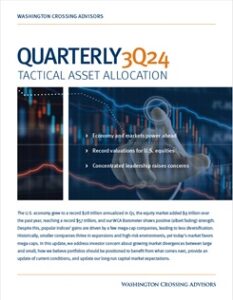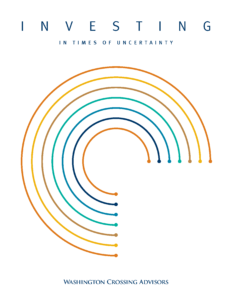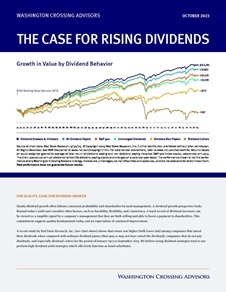Weekly (distribution list)
We expect the Federal Reserve to cut rates this week by 0.25% — the first cut since 2007. Last week, the European Central Bank signaled a willingness to cut rates and buy assets. Both banks are responding to signs of slower global growth and weakening trade. These actions would mark a turnaround in messaging from a year ago. At that time, most were expecting global rates to move higher as growth kept on an upward path. A Fine Line The central banks must walk a fine line between voicing a worrying message about growth and providing “insurance” against a potential…
The past few months have seen a marked decline in market volatility. Corporate earnings are holding steady and bond yields have declined, allowing stock values to recover from last fall’s rout. However, concerns about trade, capital investment, and global growth remain and are opening the door for central banks to ease. Our read of a broad range of data is better than six months ago, with domestic conditions winning out over foreign. Therefore, we maintain tactical tilts toward domestic over foreign, value over growth, and developed over emerging. Near-term trends in our WCA Fundamental Conditions Barometer lead us to maintain…
Evidence continues to point to continued, moderate growth in the United States economy. Take last Friday’s June employment report, for example. Jobs grew by 224,000 in the United States during June, better than expected. Hourly wages are rising 3.1%, about 1% higher than inflation, suggesting a steady backdrop for household spending. The performance was not so strong, however, as to suggest the Federal Reserve needs to revisit rate hikes anytime soon. The overall unemployment rate remains near 3.7%, below what many economists see as “full employment”, but without actual signs of inflation, there is little anxiety over a potential outbreak…
The U.S. and China backed away from escalating a trade war on Saturday at the G-20 meeting, a plus for near-term market sentiment. President Trump said the United States would hold off on new tariffs on $300 billion of Chinese goods. He also said U.S. technology companies could start selling equipment again to Huawei, China’s largest telecom company. Stalled trade talks are expected to restart. No Deal, but a Sigh of Relief The ceasefire did not produce a deal, but should remove immediate concerns. Currency markets responded positively to the announcement, for example, in the hours following the announcement and…
Normally, bond investors require higher returns to own longer dated bonds. This explains why ninety five percent of the time, 10-year Treasury bond rates are higher than 3-month T-Bill rates based on monthly observations back to 1982. The other five percent of the time, bond investors have bid up long-term Treasury bonds to such an extent that the yield on those bonds fall below short-term bills. This situation is commonly known as an “inverted yield curve” and has a strong track-record as a predictor of recessions. The chart below shows that inverted curves existed before each of the last three…
A read of incoming data puts our WCA Fundamental Conditions Barometer near 50 with an upward trend. While the current overall reading is about average, a closer look within the component parts of the barometer reveal some interesting takeaways. Notably, market based measures of risk appetite have moved in the right direction while indicators of actual economic performance have softened. Stocks and bonds have rallied together this year. The S&P 500 and the Barclays Aggregate Bond Index are up roughly 15% and 5% respectively. For now, investors are looking past signs of slowing growth, and focusing instead on the benefits…
Last week we learned the United States’ economy expanded at 3.1% from a year ago through the first quarter. As the bars in the chart below shows, this marks a continuation of an accelerating growth trend that began in 2016. The improvement came despite headwinds including an escalating U.S. / China trade war, a government shutdown, Europe’s political unrest, and volatile markets at the end of last year. The positive growth trend is not seen in business investment, however, and this is concerning to us. Last week’s GDP report, for example, revealed that nonresidential fixed investment (business investment) rose at…
A Year of Churn In the past year, forecast earnings for S&P 500 companies are up just about 9%, slightly above the S&P 500’s 5% year-on-year advance. The S&P 500 earnings yield, or inverse of the price-earnings-ratio, now stands near 6.25%, up from 5.9% a year ago. By comparison, the S&P 500 earnings yield is 385 basis points (or 3.85%) higher than the 2.4% yield on the 10-year U.S. Treasury bond. A year ago, the S&P 500 earnings yield spread over Treasuries was about 290 basis points (2.9%), so today’s 385 basis point spread points to somewhat better valuations for…
France, Germany, Spain, Portugal, Sweden, the Netherlands, Switzerland, and Japan remain stuck with negative short-term (2-year) interest rates. By comparison, at 2.3%, the United States’ two-year Treasury rates seems to be quite a bargain. However, markets are expecting that U.S. rates at the short end of the curve will not be moving higher any time soon, and could even move lower despite relatively strong growth. An investor today can lock in a rate of 2.16% in the forwards market at which that investor could borrow or lend for one year’s time one year from now. This “forward” rate is below…
The S&P 500 returned 13.7% in the first quarter, the best quarterly performance since 2009. This follows almost a 20% drop in the S&P 500 during the fourth quarter. The concerns about global growth and rising interest rates, which contributed to last fall’s market selloff, appear to be easing. The WCA Fundamental Conditions “Barometer” advanced sharply in the past few weeks as signs emerged that growth may be picking up in the United States. Accordingly, equity exposure was increased and bond portfolio duration reduced across tactical asset allocation models. Full Report Click Here
Central Banks Fall In-Line The global economy worsened in recent months by most accounts, but policy changes are now in place that could foster some improvement. Central banks in the United States, China, and Europe recently began moving toward greater accommodation — a major shift from early last fall. The Federal Reserve is telegraphing a need for “patience”, China has unveiled tax cuts and increased bank lending, and the European Central Bank (ECB) is now signaling renewed stimulus. Slipping growth is the reason cited for most of this renewed accommodation. Good Growth, Reasonable Valuation The United States growth engine appears…
Global stocks continue to gain ground compared to bonds (chart, below). Headlines on trade, the budget, and Brexit are recent market movers. The resolution of these issues, yet unknown, could shape how the rest of the year plays out. A bullish scenario envisions growth returning to the globe as nations reach compromises. An intensification of these issues, or if left unresolved, could further darken the outlook. Slowing growth in China, softening sales of homes and automobiles, weak retail sales, and a sharp decline in European industrial production are the latest signs of stress. The adoption of a “wait and see”…



